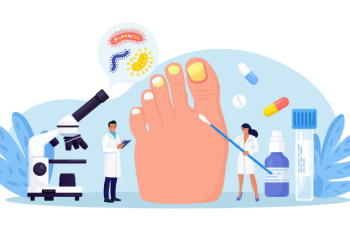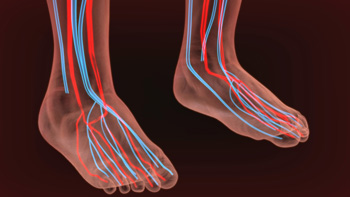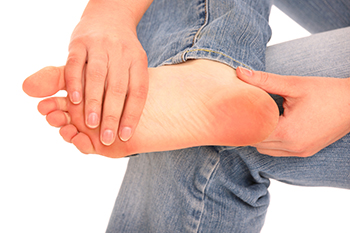Items filtered by date: July 2024
Keeping Your Feet Fit

Foot exercises are more than just stretching. They're key to maintaining overall foot health. Whether you suffer from plantar fasciitis, Achilles tendonitis, or just want to prevent future issues, these exercises can be a game-changer. By strengthening muscles and improving flexibility, foot exercises help alleviate pain and discomfort associated with common ailments. They also enhance balance and stability, crucial for maintaining an active lifestyle. Regular foot exercises can significantly reduce the risk of injuries, especially for athletes and those who spend long hours on their feet. Additionally, they promote circulation and may even improve posture. However, it's important to tailor exercises to your specific needs and consult with a podiatrist before starting any new regimen. Their expertise ensures you're targeting the right areas and avoiding potential pitfalls. So, lace up your shoes, stretch those toes, and consider scheduling a check-up with a podiatrist to keep your feet in top condition. Your feet will thank you!
Stretching the feet is a great way to prevent injuries. If you have any concerns with your feet consult with Derek Smith, DPM from Oklahoma. Our doctor will assess your condition and provide you with quality foot and ankle treatment.
Stretching the Feet
Stretching the muscles in the foot is an important part in any physical activity. Feet that are tight can lead to less flexibility and make you more prone to injury. One of the most common forms of foot pain, plantar fasciitis, can be stretched out to help ease the pain. Stretching can not only ease pain from plantar fasciitis but also prevent it as well. However, it is important to see a podiatrist first if stretching is right for you. Podiatrists can also recommend other ways to stretch your feet. Once you know whether stretching is right for you, here are some excellent stretches you can do.
- Using a foam roller or any cylindrical object (a water bottle or soda can will do), roll the object under your foot back and forth. You should also exert pressure on the object. Be sure to do this to both feet for a minute. Do this exercise three times each.
- Similar to the previous one, take a ball, such as a tennis ball, and roll it under your foot while seated and exert pressure on it.
- Grab a resistance band or towel and take a seat. If you are using a towel, fold it length wise. Next put either one between the ball of your foot and heel and pull with both hands on each side towards you. Hold this for 15 seconds and then switch feet. Do this three times for each foot.
- Finally hold your big toe while crossing one leg over the other. Pull the toe towards you and hold for 15 seconds. Once again do this three times per foot.
It is best to go easy when first stretching your foot and work your way up. If your foot starts hurting, stop exercising and ice and rest the foot. It is advised to then see a podiatrist for help.
If you have any questions, please feel free to contact our offices located in Ponca City, and Stillwater, OK . We offer the newest diagnostic and treatment technologies for all your foot care needs.
What Are the Signs of Toenail Fungus?

Toenail fungus, also known as onychomycosis, is a common condition caused by various fungi that thrive in warm, moist environments. Frequent exposure to such environments, like public swimming pools or showers, can increase the risk of infection. Additionally, wearing tight or non-breathable shoes and having minor skin or nail injuries can also make toenails more susceptible to fungal infections. Symptoms of toenail fungus can include thickened, discolored, or brittle nails that may become distorted in shape. The affected nails may also separate from the nail bed, and a foul odor can develop. In some cases, the surrounding skin may appear red and inflamed. Early detection and treatment are critical to prevent the infection from spreading and causing further complications. Maintaining good foot hygiene and wearing breathable footwear can help reduce the risk of toenail fungus. If you have developed this condition, it is suggested that you contact a podiatrist who can successfully treat it, which most likely will include prescribed medication.
For more information about treatment, contact Derek Smith, DPM of Oklahoma. Our doctor can provide the care you need to keep you pain-free and on your feet.
Toenail Fungus Treatment
Toenail fungus is a condition that affects many people and can be especially hard to get rid of. Fortunately, there are several methods to go about treating and avoiding it.
Antifungals & Deterrence
Oral antifungal medicine has been shown to be effective in many cases. It is important to consult with a podiatrist to determine the proper regiment for you, or potentially explore other options.
Applying foot powder on the feet and shoes helps keep the feet free of moisture and sweat.
Sandals or open toed shoes – Wearing these will allow air movement and help keep feet dry. They also expose your feet to light, which fungus cannot tolerate. Socks with moisture wicking material also help as well.
If you have any questions please feel free to contact our offices located in Ponca City, and Stillwater, OK . We offer the newest diagnostic tools and technology to treat your foot and ankle needs.
Common Warning Signs of Poor Foot Circulation

Poor foot circulation is a serious issue that can lead to various health complications if left untreated. Common warning signs include persistent coldness in the feet, even in warm environments. Numbness or tingling sensations, often described as pins and needles, can indicate circulation problems. Discoloration, such as a bluish or pale hue, may also be a sign of reduced blood flow. Swelling in the feet and ankles is another common symptom. Additionally, slow-healing sores or wounds on the feet can indicate poor circulation, as the necessary nutrients and oxygen are not efficiently reaching the area. Cramping or pain in the legs and feet, especially during physical activity, is another key indicator. Poor foot circulation can indicate serious health issues. If you have this condition, it is suggested that you visit a podiatrist who can determine what the reason is, and offer effective management tips.
Poor circulation is a serious condition and needs immediate medical attention. If you have any concerns with poor circulation in your feet contact Derek Smith, DPM of Oklahoma. Our doctor will treat your foot and ankle needs.
Poor Circulation in the Feet
Poor blood circulation in the feet and legs is can be caused by peripheral artery disease (PAD), which is the result of a buildup of plaque in the arteries.
Plaque buildup or atherosclerosis results from excess calcium and cholesterol in the bloodstream. This can restrict the amount of blood which can flow through the arteries. Poor blood circulation in the feet and legs are sometimes caused by inflammation in the blood vessels, known as vasculitis.
Causes
Lack of oxygen and oxygen from poor blood circulation restricts muscle growth and development. It can also cause:
- Muscle pain, stiffness, or weakness
- Numbness or cramping in the legs
- Skin discoloration
- Slower nail & hair growth
- Erectile dysfunction
Those who have diabetes or smoke are at greatest risk for poor circulation, as are those who are over 50. If you have poor circulation in the feet and legs it may be caused by PAD and is important to make changes to your lifestyle in order to reduce risk of getting a heart attack or stroke. Exercise and maintaining a healthy lifestyle will dramatically improve conditions.
As always, see a podiatrist as he or she will assist in finding a regimen that suits you. A podiatrist can also prescribe you any needed medication.
If you have any questions please feel free to contact our offices located in Ponca City, and Stillwater, OK . We offer the newest diagnostic and treatment technologies for all your foot and ankle needs.
Podiatrists Are Essential for Golfers
 Plantar fasciitis is a common foot condition in golfers due to the prolonged periods of standing and walking involved in the game. Regular foot stretches can help prevent this painful condition. Before hitting the golf course, it is beneficial to perform calf stretches by leaning against a wall with one foot forward and the other extended back. Stretching the arch of the foot by rolling a golf ball under it can also be effective. Additionally, toe stretches, where you pull your toes back towards your shin, help maintain flexibility in the plantar fascia. Incorporating these stretches into your routine not only reduces the risk of plantar fasciitis but also enhances overall foot comfort and performance on the course. Consistent stretching ensures that your feet are well-prepared for the demands of a round of golf. It is also helpful to wear shoes that have adequate arch support or to add orthotics to existing shoes, if needed. If you have developed heel pain while playing golf, it is suggested that you visit a podiatrist who can diagnose and treat plantar fasciitis.
Plantar fasciitis is a common foot condition in golfers due to the prolonged periods of standing and walking involved in the game. Regular foot stretches can help prevent this painful condition. Before hitting the golf course, it is beneficial to perform calf stretches by leaning against a wall with one foot forward and the other extended back. Stretching the arch of the foot by rolling a golf ball under it can also be effective. Additionally, toe stretches, where you pull your toes back towards your shin, help maintain flexibility in the plantar fascia. Incorporating these stretches into your routine not only reduces the risk of plantar fasciitis but also enhances overall foot comfort and performance on the course. Consistent stretching ensures that your feet are well-prepared for the demands of a round of golf. It is also helpful to wear shoes that have adequate arch support or to add orthotics to existing shoes, if needed. If you have developed heel pain while playing golf, it is suggested that you visit a podiatrist who can diagnose and treat plantar fasciitis.
Sports related foot and ankle injuries require proper treatment before players can go back to their regular routines. For more information, contact Derek Smith, DPM of Oklahoma. Our doctor can provide the care you need to keep you pain-free and on your feet.
Sports Related Foot and Ankle Injuries
Foot and ankle injuries are a common occurrence when it comes to athletes of any sport. While many athletes dismiss the initial aches and pains, the truth is that ignoring potential foot and ankle injuries can lead to serious problems. As athletes continue to place pressure and strain the area further, a mild injury can turn into something as serious as a rupture and may lead to a permanent disability. There are many factors that contribute to sports related foot and ankle injuries, which include failure to warm up properly, not providing support or wearing bad footwear. Common injuries and conditions athletes face, including:
- Plantar Fasciitis
- Plantar Fasciosis
- Achilles Tendinitis
- Achilles Tendon Rupture
- Ankle Sprains
Sports related injuries are commonly treated using the RICE method. This includes rest, applying ice to the injured area, compression and elevating the ankle. More serious sprains and injuries may require surgery, which could include arthroscopic and reconstructive surgery. Rehabilitation and therapy may also be required in order to get any recovering athlete to become fully functional again. Any unusual aches and pains an athlete sustains must be evaluated by a licensed, reputable medical professional.
If you have any questions please feel free to contact our offices located in Ponca City, and Stillwater, OK . We offer the newest diagnostic and treatment technologies for all your foot and ankle needs.
Get Professional Care for a Broken Foot or Ankle
Apophysitis and Osteochondrosis
 Apophysitis and osteochondrosis are common causes of pain in growing bones, often affecting children and teenagers. Apophysitis happens when growth plates, the areas where bones grow, become irritated from overuse or stress, sometimes affecting the feet. Osteochondrosis occurs when the bone underneath a joint's cartilage does not get enough blood, leading to pain and inflammation. These conditions usually occur during growth spurts, when bones, muscles, and tendons are rapidly changing. Activities like running, jumping, or participating in sporting activities can put extra stress on these growing areas. Symptoms can include pain, swelling, and tenderness near the affected bone or joint. The pain might worsen with activity and improve with rest. Treatment involves resting the affected area. Stretching and strengthening exercises, guided by a podiatrist, can also help. If your child is suffering from any kind of foot pain, it is suggested that you schedule an appointment with a podiatrist for an evaluation and appropriate treatment.
Apophysitis and osteochondrosis are common causes of pain in growing bones, often affecting children and teenagers. Apophysitis happens when growth plates, the areas where bones grow, become irritated from overuse or stress, sometimes affecting the feet. Osteochondrosis occurs when the bone underneath a joint's cartilage does not get enough blood, leading to pain and inflammation. These conditions usually occur during growth spurts, when bones, muscles, and tendons are rapidly changing. Activities like running, jumping, or participating in sporting activities can put extra stress on these growing areas. Symptoms can include pain, swelling, and tenderness near the affected bone or joint. The pain might worsen with activity and improve with rest. Treatment involves resting the affected area. Stretching and strengthening exercises, guided by a podiatrist, can also help. If your child is suffering from any kind of foot pain, it is suggested that you schedule an appointment with a podiatrist for an evaluation and appropriate treatment.
Foot Pain
Foot pain can be extremely painful and debilitating. If you have a foot pain, consult with Derek Smith, DPM from Oklahoma. Our doctor will assess your condition and provide you with quality foot and ankle treatment.
Causes
Foot pain is a very broad condition that could be caused by one or more ailments. The most common include:
- Bunions
- Hammertoes
- Plantar Fasciitis
- Bone Spurs
- Corns
- Tarsal Tunnel Syndrome
- Ingrown Toenails
- Arthritis (such as Gout, Rheumatoid, and Osteoarthritis)
- Flat Feet
- Injury (from stress fractures, broken toe, foot, ankle, Achilles tendon ruptures, and sprains)
- And more
Diagnosis
To figure out the cause of foot pain, podiatrists utilize several different methods. This can range from simple visual inspections and sensation tests to X-rays and MRI scans. Prior medical history, family medical history, and any recent physical traumatic events will all be taken into consideration for a proper diagnosis.
Treatment
Treatment depends upon the cause of the foot pain. Whether it is resting, staying off the foot, or having surgery; podiatrists have a number of treatment options available for foot pain.
If you have any questions, please feel free to contact our offices located in Ponca City, and Stillwater, OK . We offer the newest diagnostic and treatment technologies for all your foot care needs.

